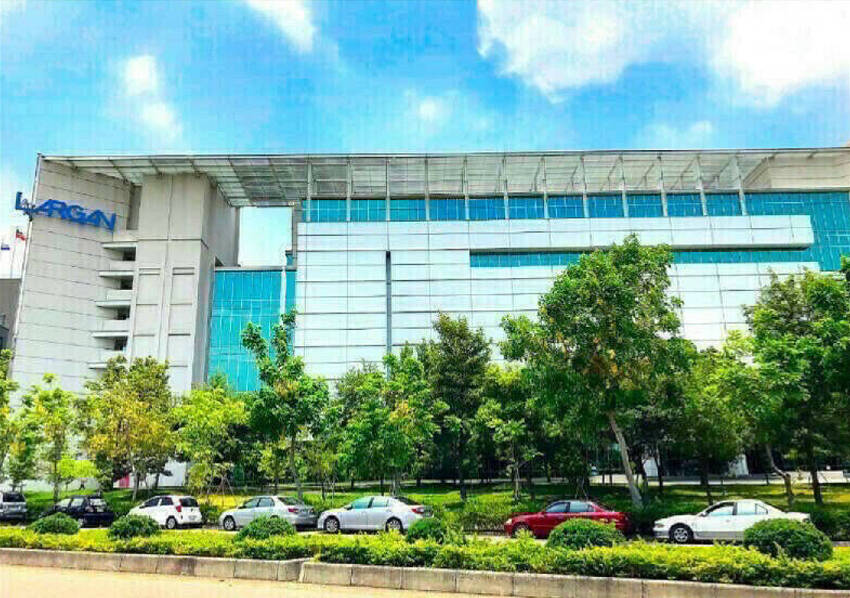Largan Precision Co (大立光), the nation’s leading handset camera lens maker, yesterday reported the highest earnings per share (EPS) for the first quarter in five years, as the company’s shares closed up by the daily maximum following days of selling.
EPS came in at NT$48.28, compared with NT$45.79 a year earlier, as the company’s net profit grew 5.44 percent year-on-year to NT$6.44 billion (US$195.9 million) from NT$6.11 billion, the company’s financial report showed.
Operating income increased 54 percent to NT$6.09 billion, but non-operating income fell 53 percent to NT$1.63 billion, the report showed.

Photo: Chen Mei-ying, Taipei Times
Gross margin improved to 54.63 percent from 49.17 percent, while operating margin improved to 41.8 percent from 35 percent, it showed.
Revenue is expected to grow more slowly in the second quarter from NT$14.58 billion in the first quarter due to seasonal factors, Largan executive officer Adam Lin (林恩平) said, adding that the US tariffs would not have a direct impact on the company’s operations.
“April sales would be weaker than March’s, and May would be even softer than April, as the second quarter typically marks the off-season for the industry,” Lin said at an online earnings conference.
As the company does not ship products directly to the US, but mostly to China and other Asian countries, a higher US tariff is not expected to affect its shipments directly, Lin said.
So far, the company has not seen signs of clients front-loading shipments, rescheduling shipping locations, or changing their purchase prices in response to the US tariff policy, he said.
In the first quarter, high-end smartphone camera lenses with resolutions above 20 megapixels accounted for about 20 to 30 percent of the company’s total shipments, lenses with 10 megapixels comprised roughly 60 to 70 percent, and lenses with 8 megapixels or fewer made up less than 10 percent, while other products took up about 10 to 20 percent, the financial report showed.
The company is capable of mass producing high-end camera lenses for Apple Inc when its key client is to release the new iPhone product line in the third quarter, Lin said.
The company is also finding no difficulty in supplying lenses for slimmer and foldable handsets, although such demand remains limited in terms of orders, he said.
As for the lens maker’s development in the humanoid service robot sector, demand for high-precision visual recognition products from its customers is likely to grow, Lin said.
Largan’s shares closed 10 percent higher at NT$1,980 yesterday, on the back of US President Donald Trump’s announcement of a 90-day pause of his “reciprocal” tariffs.
Asked whether the company would implement share buybacks to gain investors’ confidence and steady the stock’s recent fluctuations, Lin said the company’s board of directors would consider the matter, without elaborating.

TAKING STOCK: A Taiwanese cookware firm in Vietnam urged customers to assess inventory or place orders early so shipments can reach the US while tariffs are paused Taiwanese businesses in Vietnam are exploring alternatives after the White House imposed a 46 percent import duty on Vietnamese goods, following US President Donald Trump’s announcement of “reciprocal” tariffs on the US’ trading partners. Lo Shih-liang (羅世良), chairman of Brico Industry Co (裕茂工業), a Taiwanese company that manufactures cast iron cookware and stove components in Vietnam, said that more than 40 percent of his business was tied to the US market, describing the constant US policy shifts as an emotional roller coaster. “I work during the day and stay up all night watching the news. I’ve been following US news until 3am

UNCERTAINTY: Innolux activated a stringent supply chain management mechanism, as it did during the COVID-19 pandemic, to ensure optimal inventory levels for customers Flat-panel display makers AUO Corp (友達) and Innolux Corp (群創) yesterday said that about 12 to 20 percent of their display business is at risk of potential US tariffs and that they would relocate production or shipment destinations to mitigate the levies’ effects. US tariffs would have a direct impact of US$200 million on AUO’s revenue, company chairman Paul Peng (彭雙浪) told reporters on the sidelines of the Touch Taiwan trade show in Taipei yesterday. That would make up about 12 percent of the company’s overall revenue. To cope with the tariff uncertainty, AUO plans to allocate its production to manufacturing facilities in

Six years ago, LVMH’s billionaire CEO Bernard Arnault and US President Donald Trump cut the blue ribbon on a factory in rural Texas that would make designer handbags for Louis Vuitton, one of the world’s best-known luxury brands. However, since the high-profile opening, the factory has faced a host of problems limiting production, 11 former Louis Vuitton employees said. The site has consistently ranked among the worst-performing for Louis Vuitton globally, “significantly” underperforming other facilities, said three former Louis Vuitton workers and a senior industry source, who cited internal rankings shared with staff. The plant’s problems — which have not

COLLABORATION: Given Taiwan’s key position in global supply chains, the US firm is discussing strategies with local partners and clients to deal with global uncertainties Advanced Micro Devices Inc (AMD) yesterday said it is meeting with local ecosystem partners, including Taiwan Semiconductor Manufacturing Co (TSMC, 台積電), to discuss strategies, including long-term manufacturing, to navigate uncertainties such as US tariffs, as Taiwan occupies an important position in global supply chains. AMD chief executive officer Lisa Su (蘇姿丰) told reporters that Taiwan is an important part of the chip designer’s ecosystem and she is discussing with partners and customers in Taiwan to forge strong collaborations on different areas during this critical period. AMD has just become the first artificial-intelligence (AI) server chip customer of TSMC to utilize its advanced